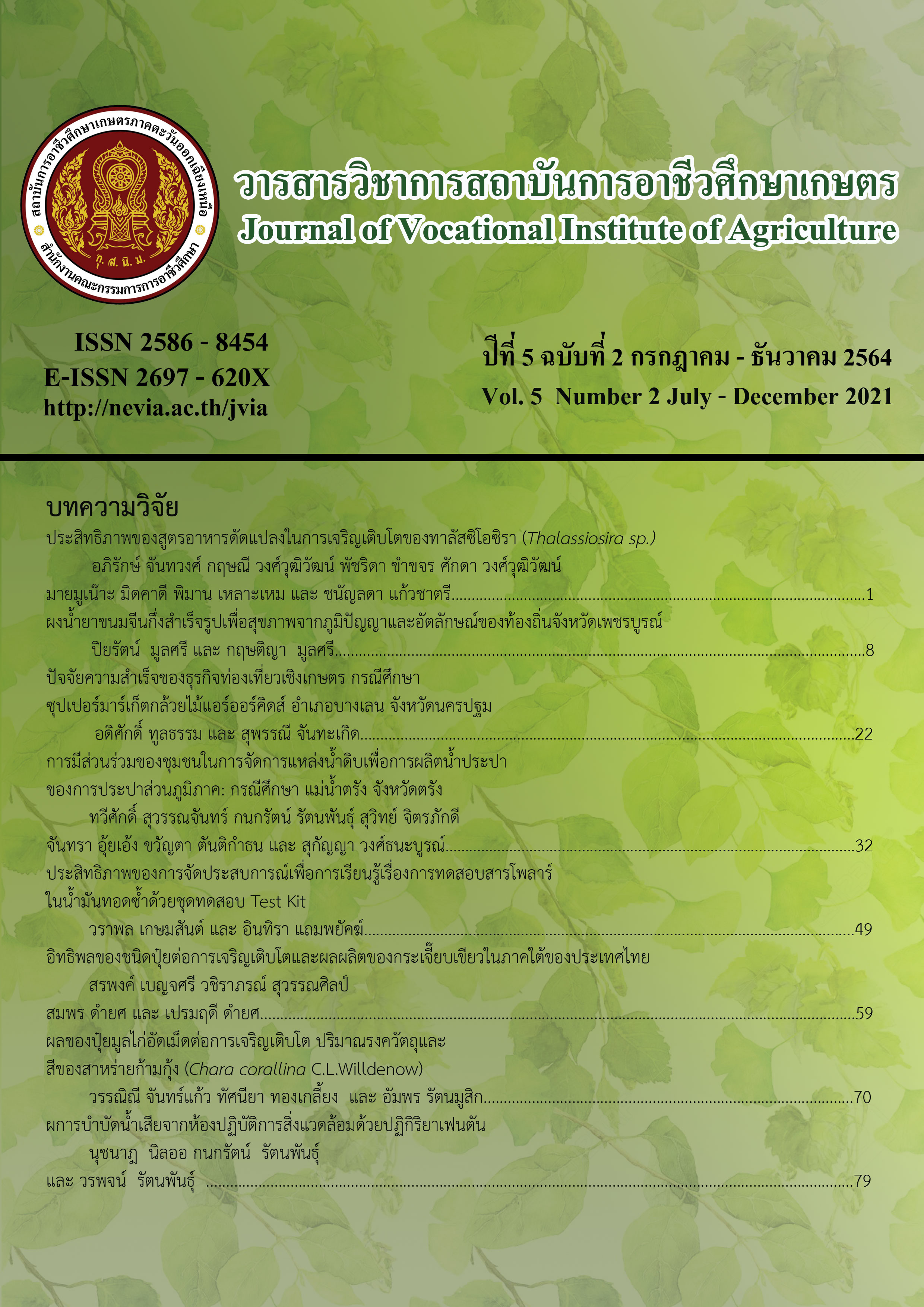Environmental Laboratory Wastewater Treatment by the Fenton Reaction
Main Article Content
Abstract
The purpose of this research was to examine the efficiency of the Fenton method for environmental laboratory wastewater treatment. The initial COD, total suspended solid (TSS) and total dissolved solid (TDS) of the wastewater were 250, 3,500 and 200,000 mg/L, respectively. The pH was adjusted to 2.0, 3.0 and 4.0, the molar ratios of H2O2:FeSO4 were 1:1, 2:1, 3:1, 4:1 and 5:1. The reaction times were 10, 20, 30, 40, 50 and 60 minutes.
The results showed that the molar ratio of hydrogen peroxide to ferrous sulfate had little effect on wastewater treatment. The stirring times resulted in different treatment efficacy. The Fenton reaction brought about the breakdown to hydroxyl radical (•OH) which was an organic oxidizing agent and this led to decreasing COD, total suspended solids and total dissolved solids. The wastewater at pH 4.0 had the highest efficiency in removal of total suspended solids and total dissolved solids. However, the water qualities after the treatment still exceeded the legal limit. The Fenton reaction was therefore only suitable for pretreatment of wastewater before further treatment.
Article Details

This work is licensed under a Creative Commons Attribution-NonCommercial-NoDerivatives 4.0 International License.
The content and information in articles published in the Journal of Vocational Education in Agriculture are the opinions and responsibility of the article's author. The journal editors do not need to agree or share any responsibility.
Articles, information, content, etc. that are published in the Journal of Vocational Education in Agriculture are copyrighted by the Journal of Vocational Education in Agriculture. If any person or organization wishes to publish all or any part of it or to do anything. Only prior written permission from the Journal of Vocational Education in Agriculture is required.
References
นาถ ภูวงศ์ผา และคณะ. (2555). การกำจัดสีและซีโอดีในน้ำเสียห้องปฏิบัติการเคมีด้วยปฏิกิริยาเฟนตัน. วารสารวิทยาศาสตร์ มข, 40(4), 1272 – 1284.
ประกาศกระทรวงทรัพยากรธรรมชาติสิ่งแวดล้อม เรื่อง กําหนดมาตรฐานควบคุมการระบายน้ำทิ้ง
จากอาคารบางประเภทและบางขนาด พ.ศ. 2548. (2548, 29 ธันวาคม). ราชกิจจานุเษกษา. เล่มที่ 122 ตอนที่ 125 ง, หน้า 4-10.
สันทัด ศิริอนันต์ไพบูลย์. (2557). ระบบบำบัดน้ำเสีย. กรุงเทพฯ: ท้อป.
Umar, M., et al. (2010). Trends in the use of Fenton, electro-Fenton and photo-Fenton for the treatment of andfill leachate. Waste Management, 30(11), 2113-2121.
Faisal, I. (2009). Oxidation of Phenolic Wastewater by Fenton's Reagent. Journal of Chemical and Petroleum Engineering, 10(2), 9-12.
Liu, X., et al. (2018). Progress in the Mechanism and Kinetics of Fenton Reaction. MOJ Ecology & Environmental Science, 3(1), 10-15.
Yazdanbakhsh, A.R., et al. (2015). Degradation of phenol with using of Fenton-like Processes from water. Iranian Journal of Health, Safety and Environment, 2(3), 325-329.
ณิชชารีย์ ธนกรจิตติพัฒน์ และกรรณิการ์ ดิษยวงศ์. (2555). การบำบัดนํ้าเสียโรงอาหารโดยกระบวนการเฟนตัน. ใน การประชุมวิชาการแห่งชาติมหาวิทยาลัยเกษตรศาสตร์ วิทยาเขตกำแพงแสน ครั้งที่ 9 (น. 1944). นครปฐม: มหาวิทยาลัยเกษตรศาสตร์ วิทยาเขตกำแพงแสน.
สายฝน มะโนคำ และคณะ. (2557). การฟอกสีน้ำเสียจากโรงงานย้อมผ้าในจังหวัดลำพูนโดยกระบวนการโฟโตเฟนตันด้วยแสงอาทิตย์. วารสารวิทยาศาสตร์และเทคโนโลยี, 22(5)(ฉบับพิเศษ), 629-640.
APHA, AWWA and WFF. (2012). Standard Method for Examination of Water and Wastewater. 22st ed. Maryland: United book press.
จันทิมา ชั่งสิริพร และคณะ. (2552). การกำจัด COD และสีในน้ำเสียจากโรงงานผลิตกล่องกระดาษด้วยปฏิกิริยาเฟนตัน. ใน การประชุมวิชาการทางวิศวกรรมศาสตร์ ครั้งที่ 7 (น. 6). สงขลา:มหาวิทยาลัยสงขลานครินทร์.
Meric, S., et al. (2004). Color and COD removal from wastewater containing Reactive Black 5 using Fenton’s oxidation process. Chemosphere, 54, 435-441.
มณฑา ประดิษฐ์ขำ. (2550). การปรับปรุงกระบวนการบำบัดน้ำเสียทางเคมีของโรงงานผลิตเคมีภัณฑ์ โดยเฟนตันออกซิเดชั่น. (วิทยานิพนธ์มหาบัณฑิต, มหาวิทยาลัยเกษตรศาสตร์).

